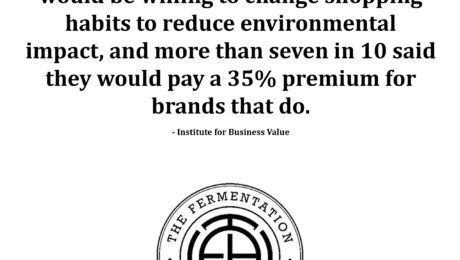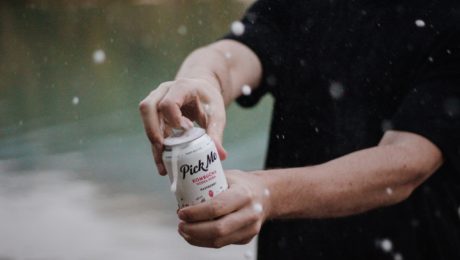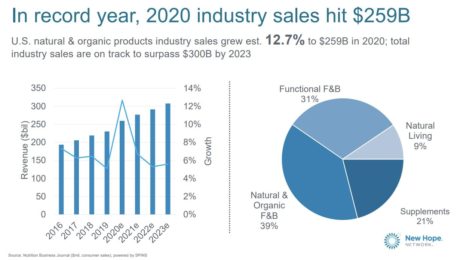Consumer’s Changing Shopping Habits
Almost six in 10 consumers said they would be willing to change shopping habits to reduce environmental impact, and more than seven in 10 said they would pay a 35% premium for brands that do.
- Institute for Business Value
- Published in Business
Fifth Time the Charm for KOMBUCHA Act?
For the fifth year in a row, the KOMBUCHA Act was reintroduced to Congress. If the legislation passes, kombucha beverages would be exempt from excise taxes intended for alcoholic beverages. The act proposes to raise the alcohol by volume (ABV) threshold for kombucha from its current level of 0.5% to 1.25%.
“The past year has been incredibly hard on businesses in Oregon and across the country, especially as supply chains have been disrupted. Still, kombucha is one the fastest growing beverage industries in the world,” says U.S. Rep. Earl Blumenauer (D-OR). “There’s no reason why kombucha brewers and sellers should get taxed like beer. Our common sense legislation would eliminate this burden and support a burgeoning industry that has a major impact on Oregon’s food and beverage economy.”
U.S. retail sales of kombucha sales grew 2.4% over the twelve months though mid-July 2020, to $703.2 million, according to SPINS.
“Modernize Taxes & Regulations”
Blumenauer first introduced the bill in 2017 — and has reintroduced it every year since. Senator Ron Wyden (D-OR), the Senate Finance Chair, is the bill’s co-sponsor.
The word “KOMBUCHA” also has a double meaning — it is an acronym for Keeping Our Manufacturers from Being Unfairly taxed while Championing Health Act. The legislators understand kombucha is a fast-growing beverage category, especially in their home state of Oregon, home to many kombucha brands.
“The growth of kombucha production in Oregon and nationwide creates jobs and a beverage folks enjoy,” Wyden said. “It’s been a particularly difficult year for small businesses, and our bill would modernize taxes and regulations so these businesses can continue to grow and sell their products in stores across the country.”
Kombucha Brewers Lobby
Commercial kombucha brewers are especially concerned with the regulation. In 2010, Whole Foods and other retailers pulled kombucha off shelves as the Alcohol and Tobacco Tax and Trade Bureau investigated whether alcohol levels in kombucha were higher than what was printed on the label. And since then, consumers — and even other brands — have filed lawsuits against various kombucha brands, alleging alcohol levels higher than indicated.
Kombucha can keep fermenting after it’s made, as the yeasts continue to eat sugars. Under current law, if kombucha leaves a processing facility at 0.4% ABV, but increases to over 0.5% by the time it’s placed on grocery store shelves, the brewer would have to pay federal alcohol taxes like a beer brand.
Hannah Crum, co-founder and president of Kombucha Brewers International (KBI), the trade organization for kombucha brewers, emphasizes that kombucha producers fear constant repercussions from the law.
“These numbers were created over 100 years ago during prohibition,” says Crum, and notes there are no scientific studies on these ABV values. “Kombucha labels say ‘Alcohol is present’ — no one is trying to trick the consumer.”
Reads a statement from KBI: “ These laws were never intended to make kombucha subject to taxes designated for beer. Passing the KOMBUCHA Act under the next appropriations bill will relieve this unnecessary burden on kombucha brewers. Only kombucha above that level (1.25%) will be subject to federal excise taxes when this Act becomes law.”
KBI has actively lobbied for the bill’s passage. Big kombucha brands (GT’s and Health-Ade) have supported the bill actively. KBI — for the first time — is asking consumers to write to their government representatives (via a form on their website) to urge them to support the bill.
- Published in Business
The Many Sides of Kefir
When Julie Smolyansky began working at her family’s Lifeway Foods business, her father advised her: “Don’t talk about the bacteria. People in America freak out about the bacteria on their food.” So when Lifeway became the first company in the U.S. to put “probiotic” on a label in 2003, it wasn’t a big surprise when customers began calling, asking for the company’s non-probiotic version of kefir.
Americans have come a long way. Consumers today search for the “live, cultured” label on fermented dairy, and gut health is a critical component of the modern diet. Smolyansky and Raquel Guajardo, author/educator, shared their thoughts on kefir during the TFA webinar The Many Sides of Kefir.
“Fermented foods were not part of the American diet, and the way that kefir and fermented foods in general were used in other parts of the world from Asian to Eastern Europe to even India and Mexico, these cultures all have fermented foods as one of their pillars as their foods sources and their health and wellness cultures,” Smolyansky says. “It wasn’t until immigration from all these other countries that we started talking about kimchi or kefir or lassi or you name your cultured kind of special food.”
In the U.S., the average person consumes 9-10 cups of fermented dairy a year. Contrast that statistic with Europe, where the average consumption is 28 cups a month.
“When you’re born consuming it and you’ve developed that taste palette, then it’s very easy to play in the space and have a diet that’s very rich in probiotics and kefir and all sorts of other fermented foods,” Smolyansky says, adding that the situation is changing in the U.S. Now, “people are hungry for it, they want it, once they learn about it, once they taste it, they fall in love with it, they’re hooked.”
Lifeway’s kefir’s sales have soared. The company was valued at $12 million when Smolyansky took over in 2002 — now it’s valued into the hundreds of millions. And even more customers have found kefir during the COVID-19 pandemic, as they adopt healthier lifestyles.
Guajardo has seen her online classes increase during COVID. The Mexico-based educator co-authored the book “Kombucha, Kefir, and Beyond” with Alex Lewin, TFA advisory board member, who moderated the webinar.
“People say ‘You’re crazy, why do you teach what to do at home what you can buy in the supermarket?’ But my business has been growing that way,” she says, adding that health benefits are the main selling point for her classes. “Why would people buy sauerkraut or kefir if you’re not explaining the benefits?”
Dairy Kefir vs. Water Kefir
Guajardo, who makes both dairy kefir and water kefir (also known as tibicos) stresses that the grains used to make each are “totally different.” Kefir grains are living bacteria and yeast microorganisms clumped together with milk proteins and sugars. They are gelatinous and white, almost like cottage cheese. Water kefir grains are also made from living bacteria and yeast microorganisms, but they’re clumped together with sugar and have a translucent, crystal-like appearance.
“Water kefir” is not the appropriate term, Guajardo and Smolyansky agree, instead calling it by its traditional Mexican name, tibicos. And they feel that using kefir or tibicos grains in coconut or almond milk and calling it kefir is also inappropriate. Smolyansky favors using a description like cultured coconut milk or beverage, but not kefir.
The National Dairy Council and Codex Alimentarius, the international food code, both state kefir is a fermented dairy product made from the milk of a lactating mammal. Smolyansky points to the many peer-reviewed studies on kefir, verifying it is full of probiotics and nutrients. Water kefir and non-dairy kefir have not been studied, and can’t guarantee the same health benefits.
“Just by throwing the name onto anything and just bastardizing the definition, we completely dilute any of the research that’s ever been done [on kefir], it would dilute the history, the folklore. So we are very passionate about protecting the name,” Smolyansky says. “My ancestors made sure that kefir survived for 2,000 years, and it’s critical that we don’t dilute it now that it’s having a moment, now that it’s popular.”
Smolyansky’s family emigrated to the United States from the then Soviet Union in the late ‘70s. Her father, Michael, began Lifeway Foods in Chicago in 1986.
“We have to respect the standards and what these definitions mean or it will be the Wild West and people won’t know what they’re buying,” she adds. She shares the labelling of ice cream as an example — ice cream is considered dairy while non-dairy products have other names, like sorbet, gelato or non-dairy frozen dessert.
Can Kefir Grow Like Yogurt?
Yogurt has paved the way for kefir to expand its consumer base in the U.S. Both are fermented dairy products with tangy tastes. But for kefir to achieve widespread, mainstream adoption like yogurt, significant education is needed. Thousands of peer-reviewed studies prove kefir contains a higher concentration of probiotics than yogurt — and a wider range of beneficial bacteria. For kefir to grow, this message needs to reach consumers.
“It’s a different set of microbes,” Lewin says. “Kefir is fermented with yeast and yogurt isn’t. Kefir has a larger family of microbes.”
Smolyansky is passionate that kefir cannot be compared to the products of the major. yogurt companies.
“The yogurt produced in the United States is so over-produced and so over-pasteurized that there’s practically nothing living in it after it’s been processed,” she says. “It’s one of the biggest problems with yogurt in the U.S.”
Lifeway regularly sends their products to be tested for probiotics, measuring Colony Forming Units (CFUs), the active microorganisms in a food product. Smolyansky says eating probiotics is critical in a germ-phobic, antibody-heavy society, where we’re over-sanitizing due to the coronavirus pandemic.
“If our bodies aren’t fighting an outside kind of pathogen, it starts to fight itself,” she says. “One of the ways to counteract this disruption in our microflora is by the use and the introduction of consistently replenishing microflora including diversity of bacteria, a variety of food sources that offer bacteria, the diversity and kind [of bacteria] is always the king. It makes for great food environments in the gut.”
- Published in Business, Food & Flavor
Retail Sales Trends for Fermented Sauces
Shelf-stable fermented sauces are growing tremendously. In the past year, fermented sauces grew 41%, with sales reaching $275 million. Soy sauce still dominates with 70% of the market share, but sales of both fish sauce and gochujang increased over 50%.
“I think a lot of brands are thinking ‘Are we going to hang onto this new [normal], this new baseline?’ This is a segment of products that’s really having its baseline reset,” says Kevin Snodgrass, solutions architect for SPINS. Snodgrass shared insights in a TFA webinar, Retail Trends for Fermented Sauces. “Brands are going to continue to experience this great growth in the months and years ahead.”
The increase is significant — sales growth in the one year from 2019 to 2020 was 5.7%. This improvement is attributable to multiple trends across the food industry — more people are buying healthy food and cooking at home, the American kitchen is becoming more globalized, and more consumers are embracing the unique flavors of fermented sauces, especially those from Asia.
“It definitely coattails a lot on the acceptance and growth of the fermentation market as a whole,” says Jared Schwartz, a TFA Advisory Board member who moderated the webinar. Schwartz is the founder of fermented sauce producer Poor Devil Pepper Co., and director of operations and quality for Farm Ferments, a facility in Hudson, N.Y., that is home to Hawthorne Valley Farm. “As consumers are becoming more open to reaching for fermented foods, kind of the next step is adding a flavorful, fermented hot sauce.”
Brands Growing, but Room for More
The top 10 selling fermented sauce brands in both natural retail grocers (like Whole Foods) and traditional (MULO) outlets (like Wal-Mart and regional grocery chains) are all experiencing double-digit growth. “That’s a great sign,” Snodgrass notes.
Kikkoman, Bragg, San-J, Coconut Kitchen, Lee Kum Kee and Big Tree are among the top 10 brands in both the natural and MULO channels. Smaller brands like Red Boat, Mother-In-Law’s, Ohsawa and Yamasa thrive in the natural channel,; La Choy, BetterBody Foods and Chung Jung One are strong in MULO.
The category is ripe for continued innovation, Snodgrass says. Smaller brands can emerge, even with competition from larger, established brands, so it can be worthwhile to start a fermented sauce brand.
Label Claims & Consumer Education
SPINS found certain product attributes on fermented sauces help sales.. Certified gluten-free fermented sauces grew 40.8%; USDA organic, up 40% and non-GMO increased 33.8%.
Since many sauces don’t put “fermented” on their label, many consumers may not be aware they are, notes Snodgrass. He says that these products could benefit from using “fermented,” as it would suggest that there may be health benefits to the sauces.
Schwartz agrees. He points out Tabasco as a fermented hot sauce, even though producer McIlhenny Company doesn’t market it as such. Educating the consumer would also help the category. Probiotics are a selling point but they confuse buyers. And there’s a clear difference in health benefits between shelf-stable and refrigerated fermented sauces. Refrigerated sauces may have live, beneficial bacteria; shelf-stable ones are pasteurized, killing any good bacteria in the process.
“At the end of the day, I think it comes down to flavor,” Schwartz says. Fermented sauces are “funky and vinegar-free. It’s got this like natural layers of complexity that you can’t really achieve without fermentation.”
- Published in Business, Food & Flavor
The Future of Fermentation Biotechnology
Leaders in the biotechnology industry are calling fermentation “Agricultural 2.0.” As consumers continue to seek alternative protein and dairy options, more biotech companies are using fermentation to produce alt-proteins. Ricky Cassini, co-founder and CEO of natural food colourant start-up Michroma, says: “The fermentation space is thriving and there is a lot of progress around this technology.”
Here are three expected developments in fermentation processing this year:
- More dairy-free cheese products will enter the market.
- Price points for alternative proteins will drop as more players enter the market.
- Regulatory issues and naming conventions will gain in significance.
Read more (Food Navigator)
Are Cider Clubs Worth it?
In the past decade, more cideries have begun clubs as a way to connect with their customers, keep year-round sales and sell rare ciders.
But during 2020, when the COVID-19 pandemic closed taprooms and cancelled restaurant sales, cider clubs became critical to earn revenue. The American Cider Association (ACA) reported 22% of their members started a club in 2020.
“Our cider club was the one bright spot of 2020. That was really the one thing that kept growing, kept us motivated and got us excited,” says Talia Haykin, founder of Colorado-based Haykin Family Cider. Her products were sold in local fine dining establishments, but those sales evaporated during the pandemic.
“Everyone has kegs they can’t sell during the pandemic,” says Christopher Shockey, who co-authored the book The Big Book of Cider with wife Kirsten (a TFA Advisory Board member). “Cider clubs are keeping them afloat.”
Guaranteeing Sales & Creating Fans
Cider clubs are a subscription service where the cidery ships new, rare, seasonal or limited edition ciders to members multiple times a year. As both online shopping and access to direct-to-consumer alcohol shipping have expanded, subscriptions to cider, wine and other alcohol assortments have become feasible and increasingly popular.
“It’s taking customers who are already excited about you and converting them into a model that’s going to have them buy more from you regularly” says Eleanor Leger, founder of Eden Speciality Ciders. Leger and Haykin shared their tips on cider club growth opportunities during 2021 CiderCon.
“That’s money you know you’re going to have versus just duking it out on the store shelves where a new store manager can just decide they don’t want you and they want somebody else and you lose that shelf space,” Christopher says during the TFA webinar on “The State of the Art of Cidermaking.”
An ACA survey found that cider clubs generate up to 10% of a cidery’s total revenue.
Quarterly shipment of ciders is standard. Haykin and Leger advise cideries to ship more than twice a year, so members won’t forget they joined a club.
“You want to continually remind them that you exist,” Haykin says.
Shipping costs for cider — a fermented product which must be kept cold and is often sold in glass bottles — can be pricey. But, Haykin notes, even though he bears that high cost of shipping : “the repeat business of a club member is worth so much more to us.” Many clubs offer local pick-up to eliminate shipping costs.
Attracting & Keeping Customers
In the crowded alcohol market, cider clubs are a way to differentiate a brand.
While there are not specific stats on the demographics of Americans who subscribe to alcohol clubs, product subscription services overall are rapidly growing. Millennials are the dominant users of subscriptions — 31% currently have one or more, and another 38% say they will in the next six months.
Cider sales grew 9% in 2020, and they represent 11% of the craft beer category (where cider sales are tracked). Wine is struggling with Millenial and Gen Z consumers, who view it as a drink for an older demographic. Kirsten Shockey says younger consumers gravitate to cider instead.
“People are looking for funky flavors,” she adds. “I think the biggest battle cider makers have is feeling like the wine cooler crowd is their crowd. But that is changing, people are looking for more flavor.”
Member offerings vary for cider clubs, and can include:
- Discount on tap room products.
- First chance to try new items.
- Exclusive taproom tastings.
- Forage days (members help pick cider apples from local orchards).
- Volunteer opportunities at local farmers markets and food festivals.
The No. 1 reason people cancel a membership is because of a bad experience. Haykin stresses the importance of responding to a customer within, at most, 12 hours. “Communication is one of the most important things you’ll offer as a club,” she says.
Leger adds: “We jump all over someone who has had a problem to make sure they know we are sorry and we take care of it right away. Handling a problem really well creates incredible loyalty. People can be out there building your brand for you because they love you and they’re telling all their friends. If they have a bad experience, they’re destroying the brand for you.”
- Published in Business
Fermented Foods Fighting Food Insecurity
Fermenti Foods has teamed up with a local salt producer to help food insecurity in their local county of Madison County, North Carolina.
Meg Chamberlain (pictured) donates jars of her fermented kraut and carrots to the Beacon of Hope Food Bank. She’s also helped the food bank preserve fresh food donations. And now she’s adding recipes for sauerkraut and tutorials on YouTube. Chamberlain says fermentation is a useful tool for home preservation.
“In addition to the fact that more people are growing, they need to know what to do with what they’re growing in their gardens,” she said.
Read more (Citizen Times)
Zilber on Leaving Noma for Bioscience Corporation
A sustainable food industry will be built by flavor, says David Zilber, noted chef and food scientist.
Zilber made major headlines and surprised many in October when he left his job as head of the fermentation lab at Noma for a food scientist position at Chr. Hansen, a global supplier of bioscience ingredients. Noma, a two-Michelin star restaurant in Copenhagen, Denmark, has been regularly ranked one of the best restaurants in the world. In 2018, Zilber co-authored a bestselling book on fermentation with Noma co-owner Rene Redzepi.
In an Instagram live interview last week with Al Jeezera’s Femi Oke, Zilber elaborated on why he traded an apron for a lab coat. The global food system, Zilber says, is unsustainable. Waste is prevalent, food is created with long footprints, agricultural production is shrinking, meat is heavily consumed and large corporations control the industry.
Transforming Vegetables
“What I’m trying to do in my work is to make vegetables as God damn tasty as they can possibly be by using microbes, using things that are already at our disposal, and convincing people that this might have to have a little bit of a longer inventory life while you let it ferment, while you build a stockpile, but this is the result, this is why you’ll be able to convince people why eating this way is healthy for them and the planet,” he says. “Flavor is king.”
Ingredients created by Denmark-based Chr. Hansen (the company has 40,000 microbial strains used as natural ingredients) feed 1-1.5 billion people a day. These include microbes in yogurt and yeast in beer.
“I work with them to try and make the food system more sustainable, to get more people eating vegetables,” Zilber says, adding that 30% of every calorie consumed by humans is fermented by bacteria, microbes or fungus. “No matter what we eat in the future, that’s still going to be the case. That slot of the human diet still needs some form of microbial transformation, whether it’s meat or dairy or oat milk or peas. I work to figure that out.”
It’s a different philosophy compared to the food technology many new companies are utilizing to create alternative proteins like Beyond Burger. He complimented the company for their high standards, but he says a Beyond Burger patty is not a replacement for a juicy, beef burger. People pay more for an inferior eating experience.
“At the end of that day, that will not cut it,” Zilber says. “Why does food have to be that processed to be purportedly that delicious? With some skilled tricks in the kitchen, with some ninja jiu jitsu behind the stove, you can make vegetables really, really delicious.”
Sustainable Food Systems
A sustainable food system will look much like one from 300 years ago, Zilber hypothesizes. It will be localized, where people purchase food produced close by. Modern practices of shipping ingredients and processed food around the globe are harmful to the environment.
“A truly sustainable food system looks far more decentralized than [the current one] does right now. There are [only a] very few stakeholders that are responsible for really a lot of calories,” he continues.
Oke questioned how Zilber could change a broken food system controlled by large companies when he now works at one of the major companies.
“If you want to be an idealist, that’s great, you might end up being a martyr,” Zilber says. “Sometimes you have to work within those contradictory institutions to try to do as much good as possible.”
Restaurant Industry’s Responsibility
The restaurant industry plays a part in it too, Zilber says. Workers are stretched thin, overworked, underpaid “and then extremely vulnerable in a time of crisis.” The pandemic has exposed and highlighted these problematic parts of the restaurant business.
Zilber says there are still too many restaurants. It’s hard to find good cooks, and staff is often undertrained.
“I took a step into food production myself. Maybe more of these cooks, more of these people who are passionate about food, need to consider options beyond just the restaurant setting and see value in becoming a farmer, becoming a distributor, becoming someone who decides how those calories are made because restaurants aren’t the full picture of the food system,” he continues. “There are a lot of talented people within it who know food, who understand it, who understand the human experience of what it means to make good tasting food and satisfying food. There’s other places for them to work as well.”
- Published in Business
Natural & Organic Sales Grow Big in 2020
Natural and organic products had a record year in 2020, growing 12.7% to $259 billion in sales. Sales were fast-tracked by the pandemic, as consumers cooked more meals at home in quarantine and developed a greater interest in healthier food and beverages.
“2020 was a challenging year. But natural and organic brands face a bright future. We are positioned where a growing number of consumers are headed,” says Carlotta Mast, senior vice president and market leader at New Hope Network. Mast shared industry highlights during her State of Natural & Organic address at New Hope’s Spark Change virtual conference earlier this month.
Natural and organic food and beverages (39%of total sales) and functional food and beverages (31%) dominate the industry. The natural and organic category alone grew 13% to $186 billion in sales. Produce accounted for 24% of those sales. Beverages were 17% of the total; dairy, 15%; packaged/prepared foods, 13%; breads and grains, 11%; snacks, 8%; meat, fish and poultry,7% and condiments, 5%.
Here are some key trends from this banner sales year:
- Consumers Prioritize Health
Consumers want immunity-boosting foods. Brands should consider adding vitamins and minerals to their products, as nutrient-dense food will be core to the future of food production.
Nutrient density “is very difficult to market,” says Nick McCoy, managing director and co-founder of Whipstitch Capital, a food-focused investment bank. “It manifests itself as superfoods over time, but it’s one of these things, if you’re in a natural grocery store, historically not many shoppers are going to take the time to read the label. It’s really encouraging to see that this is reversing.”
Adds Kathryn Peters, executive vice president at SPINS, a data company for the natural and organic industry: “Consumers are expecting more from the products they buy. But another key piece is consumers are expecting more density of nutrition in the products they buy.”
- Wellness is Challenging to Maintain
Consumers are focusing on health and wellness more than ever — 77% of New Hope Network survey respondents said personal health is more important to them now than it was in 2019.
But research shows consumers are struggling to maintain healthy lifestyles. People said they ate more junk food, exercised less, felt more anxious and slept less during 2020. Binge drinking is up an alarming 41% among women since the start of the pandemic.
Brands, Mast says, can help people fix bad habits.
“I think this is our big opportunity for 2021 and beyond,” Mast says.
- Diet as Lifestyle
SPINS’ Peters says she anticipates that, “as we look to resurrect our former selves,” shoppers will look for new eating plans, ones they can personalize to their needs.
She highlighted a few trends. Consumers want less sugar and fewer carbs and additives. They’re also shifting buying habits based on the trend to Paleo and Keto diets. Plant-based products, too, are estimated to grow at twice the rate of their traditional counterparts. Plant-based products grew 30% from 2019 to 2020, hitting $5.7 billion in sales.
Pantry staples, frozen foods, meat/fish/poultry and plant-based alternatives experienced the highest growth rates. Snack foods and packaged and prepared foods — which had previously experienced large sales gains — took big hits in 2020 as fewer people chose grab-n-go offerings during quarantine.
“How is your brand interacting with what consumers are looking for today?” Peters says.
- Multicultural Foods Grow
Of health and wellness products in the U.S., only 20% are multicultural, according to the Nutrition Business Journal.
“That tells me there’s a lot of room for better-for-you multicultural foods to grow into the profile of all the other categories,” Whipstitch’s McCoy says.
- Differing Preferences for eCommerce or Brick-and-Mortar
The pandemic accelerated ecommerce sales, which grew 60% in 2020, generating $16.5 billion. Natural products are outpacing traditional ones in ecommerce, with natural product shoppers spending nearly twice as much as those who buy “traditional” items via ecommerce. And, while “traditional” shoppers spend 22% of their dollars at WalMart, natural product shoppers only use WalMart for 12% of their purchases.
“As you all know, organic is mainstream now,” Mast continued, noting that natural sales remained high in 2020 even as unemployment rates soared. “During other economic downturns that we’ve experienced, the organic sector has typically taken a hit when it comes to sales growth. But not in 2020.”
- Published in Business
New FDA Requirements for Fermented Food
By August, any manufacturer labeling their fermented or hydrolyzed foods or ingredients “gluten-free” must prove that they contain no gluten, have never been through a process to remove gluten, all gluten cross-contact has been eliminated and there are measures in place to prevent gluten contamination in production.
The FDA list includes these foods: cheese, yogurt, vinegar, sauerkraut, pickles, green olives, beers, wine and hydrolyzed plant proteins. This category would also include food derived from fermented or hydrolyzed ingredients, such as chocolate made from fermented cocoa beans or a snack using olives.
Read more (JD Supra Legal News)










